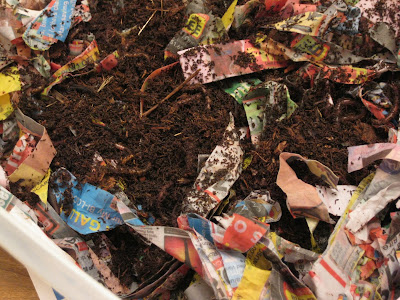I woke up this morning at 9:30, which you'd think was a nice normal time, except I went to bed around 3 and somehow my body STILL doesn't get the concept of sleeping in. Compared to my usual 5 though, I guess 9:30 is a big deal. Anyway, I decided if I was going to be awake for a larger part of the day than I had planned, I should do something with it. (Besides the silly UNCC assignment I have to submit before midnight. Ugh.) I've been reminiscing about Chicago lately, with the "fall" weather here in Charlotte skirting around an appropriate level of cold. One of the many, many things I loved about my life there was my giant bin of worms!!

It sat in the corner of my Chicago kitchen, and as you can see in the photo, was always kind of big and awkward. Super convenient for chucking vegetable peelings in as I was cooking, but also pretty ugly.
So, for my new worm bin, I got a smaller Tupperware:

For anyone who's interested, it's incredibly easy to convince worms to make you some compost. At the nature museum in Chicago, we did a bunch of workshops for people where they got to take home little starter bins and they were always a big hit. You just need a Tupperware bin with a lid, wet newspaper, a drill, and worms.
You can get red wigglers (also called red worms, or if you're super fancy,
Eisenia foetida) at PetSmart. Most pet stores carry them as food for toads and lizards and whatnot, but they aren't always in stock. You don't want night crawlers or earthworms - they're totally different. The guy at PetSmart had three containers today, but I just grabbed two.

There's some estimate I've read that says something like you need two pounds of worms for every one pound of food scraps each day. Since I do not produce a pound of food waste every day, I did not get two pounds of worms. That's like 2000 worms. I think I had about 200 worms to start with in my Chicago bin, but they reproduce quickly when they're happy, so I had a lot more than that when I finally gave the bin away before moving.

They come packed in some peat-mossy-type bedding, which I just dumped into the bins along with the worms. Along with the worms, you put in a good layer of damp newspaper, cut into strips or shredded. Easiest way to get it right is to dunk a big wad of it in water, then wring it out like a sponge. The newspaper should be damp but not drippy.

The worms will eat the paper, and it gives them something to burrow in. Then when you start to add food scraps, you bury the scraps under the paper and the worms will go to town. You can use brown grocery bag paper too.

Make sure you've got holes drilled in the lid for ventilation, and you're good to go. With a lid on it, you shouldn't have to moisten your worms much, if at all. Keep them someplace that isn't too cold or too hot, and if the bin is see-through like mine, someplace dark. Just add food scraps under the newspaper bedding, and sooner or later your bin will start to look like a pile of compost instead of a pile of newspaper.
To harvest it, what I always did was shove all the composty-stuff to one side, put in new newspaper and food scraps on the other side, and in a couple days all the worms will move over to the new food. Then you can just scoop out the compost, sift through it to make sure you don't have any stragglers, and it's good to go for your plants! You can put most plant-based food scraps in it, but some things like onions and broccoli will start to smell bad before your worms can break them down fully. Also avoid citrus fruits - they're not a big fan of those. But anything else, raw or cooked, as long as it isn't oily, and doesn't include animal products. They can eat tea bags and coffee grounds too. My little guys have some old apple chunks and spent Earl Grey to get started on. Tasty treats.
I'm so happy to have some worms back in my life. It felt so wrong throwing carrot peelings in the trashcan when there are starving worms in China.















